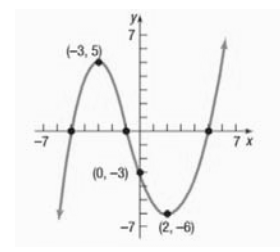
In parts (a) to (f), use the following graph,

Find the intercepts
Based on the graph, tell whether the graph is symmetric with respect to the x- axis, the y- axis, and/or the origin.
Based on the graph, tell whether the function is even, odd, or neither.
List the interval on which
List the number, if any, at which
List the number, if any, at which
(a)
The intercepts of the graph

Answer to Problem 19CR
Solution:
The
Explanation of Solution
Given information:
The graph

Explanation:
By observing the graph, the graph crosses
Therefore, the
(b)
Whether the following graph is symmetric with respect to the
The graph

Answer to Problem 19CR
Solution:
The graph is neither symmetric with respect to the
Explanation of Solution
Given information:
The graph

Explanation:
By observing the graph, it is observed that the graph is neither symmetric with respect to the
(c)
Whether the following graph of function is a graph of even, odd, or neither function.
The graph

Answer to Problem 19CR
Solution:
The function is neither.
Explanation of Solution
Given information:
The graph

Explanation:
If
Here, by observing the graph, it is observed that
(d)
The intervals on which

Answer to Problem 19CR
Solution:
Explanation of Solution
Given information:
The graph of

Explanation:
By observing the graph, it is observed that
(e)
At which,
The graph of

Answer to Problem 19CR
Solution:
Explanation of Solution
Given information:
The graph of

Explanation:
From the graph, it is observed that
Hence, the local maximum of
(f)
At which,
The graph of

Answer to Problem 19CR
Solution:
Explanation of Solution
Given information:
The graph of

Explanation:
From the graph, it is observed that
Hence, the local minimum of
Chapter 4 Solutions
Precalculus
Additional Math Textbook Solutions
Thinking Mathematically (6th Edition)
Introductory Statistics
University Calculus: Early Transcendentals (4th Edition)
Basic Business Statistics, Student Value Edition
Elementary Statistics
Algebra and Trigonometry (6th Edition)
- = 5 37 A 4 8 0.5 06 9arrow_forwardConsider the following system of equations, Ax=b : x+2y+3z - w = 2 2x4z2w = 3 -x+6y+17z7w = 0 -9x-2y+13z7w = -14 a. Find the solution to the system. Write it as a parametric equation. You can use a computer to do the row reduction. b. What is a geometric description of the solution? Explain how you know. c. Write the solution in vector form? d. What is the solution to the homogeneous system, Ax=0?arrow_forward2. Find a matrix A with the following qualities a. A is 3 x 3. b. The matrix A is not lower triangular and is not upper triangular. c. At least one value in each row is not a 1, 2,-1, -2, or 0 d. A is invertible.arrow_forward
- Find the exact area inside r=2sin(2\theta ) and outside r=\sqrt(3)arrow_forwardA 20 foot ladder rests on level ground; its head (top) is against a vertical wall. The bottom of the ladder begins by being 12 feet from the wall but begins moving away at the rate of 0.1 feet per second. At what rate is the top of the ladder slipping down the wall? You may use a calculator.arrow_forwardExplain the focus and reasons for establishment of 12.4.1(root test) and 12.4.2(ratio test)arrow_forward
- Use 12.4.2 to determine whether the infinite series on the right side of equation 12.6.5, 12.6.6 and 12.6.7 converges for every real number x.arrow_forwarduse Cauchy Mean-Value Theorem to derive Corollary 12.6.2, and then derive 12.6.3arrow_forwardExplain the focus and reasons for establishment of 12.5.4arrow_forward
 Calculus: Early TranscendentalsCalculusISBN:9781285741550Author:James StewartPublisher:Cengage Learning
Calculus: Early TranscendentalsCalculusISBN:9781285741550Author:James StewartPublisher:Cengage Learning Thomas' Calculus (14th Edition)CalculusISBN:9780134438986Author:Joel R. Hass, Christopher E. Heil, Maurice D. WeirPublisher:PEARSON
Thomas' Calculus (14th Edition)CalculusISBN:9780134438986Author:Joel R. Hass, Christopher E. Heil, Maurice D. WeirPublisher:PEARSON Calculus: Early Transcendentals (3rd Edition)CalculusISBN:9780134763644Author:William L. Briggs, Lyle Cochran, Bernard Gillett, Eric SchulzPublisher:PEARSON
Calculus: Early Transcendentals (3rd Edition)CalculusISBN:9780134763644Author:William L. Briggs, Lyle Cochran, Bernard Gillett, Eric SchulzPublisher:PEARSON Calculus: Early TranscendentalsCalculusISBN:9781319050740Author:Jon Rogawski, Colin Adams, Robert FranzosaPublisher:W. H. Freeman
Calculus: Early TranscendentalsCalculusISBN:9781319050740Author:Jon Rogawski, Colin Adams, Robert FranzosaPublisher:W. H. Freeman
 Calculus: Early Transcendental FunctionsCalculusISBN:9781337552516Author:Ron Larson, Bruce H. EdwardsPublisher:Cengage Learning
Calculus: Early Transcendental FunctionsCalculusISBN:9781337552516Author:Ron Larson, Bruce H. EdwardsPublisher:Cengage Learning





